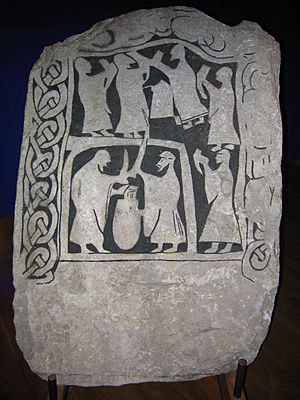Symbel facts for kids
Symbel (from Old English) and sumbl (from Old Norse) are old Germanic words for a "feast" or "banquet." These were not just regular parties. They were important gatherings with special rituals.
People in Anglo-Saxon and Norse cultures held symbel events. We know about them from old writings like the Anglo-Saxon poem Beowulf and Norse sagas such as Heimskringla. Scholars believe these events had a deep religious meaning for early Germanic people.
Contents
What Was Symbel?
Symbel was a special kind of gathering. It was usually held indoors, often in a chieftain's large hall. It was more serious than a simple celebration. The main parts of a symbel included:
- Drinking ale or mead from a drinking horn.
- Making speeches, which often included boasts or promises.
- Giving gifts.
Eating and general feasting were usually separate from the symbel ritual itself. Also, no alcohol was set aside as a sacrifice to the gods during this specific ritual.
Symbel in Anglo-Saxon Times
In old English poems, especially Beowulf, feasts were very important. They helped unite the community and made warriors loyal. They also encouraged warriors to be brave.
- In Beowulf, a person called Unferth acted as a special official at the feast. He would challenge and question guests, sometimes even teasing them. This was expected of him.
- Warriors often made a boast (called gielp or gylp) or a promise (called beot) at these feasts.
- Another important person at a feast was the scop. A scop was like a poet or storyteller. They would recite family histories, old stories, and poems.
- Women or "ale bearers" served the alcoholic drinks. The lady of the house usually poured the first round.
Scandinavian cultures also had similar important feasts.
The Bragafull (Promise-Cup)
The bragarfull was a special "promise-cup" or "chieftain's cup." It was used in Norse culture during ceremonies. People would drink from this cup or a drinking horn. Often, important promises or oaths were made when the chieftain drank from it, or as it was passed around.
The word bragr means "best" or "foremost." So, bragafull can mean "best cup." Some also think it could mean "Bragi's cup," referring to the god of poetry, but there's no strong link to him in old stories.
Snorri Sturluson, a famous Icelandic historian, described the bragarfull custom in his book Heimskringla. He wrote that during feasts, people would drink special goblets:
- First, a goblet for Odin for victory and power.
- Then, goblets for Njörd and Freyja for peace and good seasons.
- After that, many people would drink the bragafull.
- Finally, guests would drink a goblet to remember friends who had passed away. This was called the minni (remembrance).
Snorri also wrote about how a new king would take his place. He would sit in front of the main seat until the bragafull was brought. Then, he would stand, take the cup, make a serious promise, and drink it. After that, he would sit on his father's throne, officially becoming the new ruler. For example, King Ingjald once promised to make his kingdom twice as big, or die trying, when he drank the bragafull.
The Minni (Memory)
The word minni means "remembrance" or "memory." It was used for ritual drinking to remember the gods. Terms like "memory-ale" (minnis-öl) or "memory-horn" (minnis-horn) were used. People would drink "memory-cups" dedicated to specific gods like Odin, Njörd, or Frey.
Even after Christianity came to these lands, the custom continued. People then drank minni to Christ, Mary, and the saints.
The minni for gods or saints was usually at the start of the drinking ritual. Later, people would also drink minni to remember their friends who had died. The German word minne comes from the same root. It also meant "remembrance of absent or lost loved ones."
Symbel Today
Inspired by old theories, the symbel has become an important ritual in modern Heathenry. This is a modern pagan religion. In this version, a drinking horn filled with mead or ale is passed around. People make toasts, usually to gods, ancestors, or heroes of their religion.
The toasts can be different depending on the group. Some groups have different levels of formality for their symbel. Participants might also boast about their own achievements or make promises about future actions. Words spoken during the symbel are taken very seriously. Any promises made are considered sacred.
The name sumbel or symbel mostly comes from Anglo-Saxon sources. Because of this, Icelandic Nordic pagans don't use this exact name. However, they do practice a similar ritual as part of their blot (a different type of sacrifice or worship).
In Theodism, which is Anglo-Saxon neopaganism, the symbel is very important. It's seen as one of the most sacred rituals. Symbel involves rounds of ritual drinking and toasting. It always happens indoors. It usually starts with three formal rounds led by the host. These often include toasts to the Gods, then to ancestors or heroes, and then a general or personal boast.
There are two types of boasts:
- The ȝielp (pronounced 'yelp') is a boast about one's own worth, like achievements or family history.
- The beot (pronounced 'bayawt') is a promise about an action one plans to do.
To protect the good luck of the hall, these boasts can be challenged by the thyle. The thyle's job is to make sure that unlucky boasts don't bring bad luck to everyone present. Symbel is always formally ended once the main boasts are done. This helps keep the event dignified and prevents it from turning into just a regular party.



